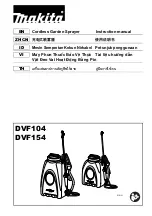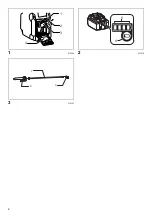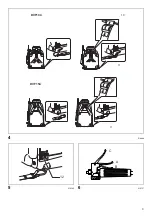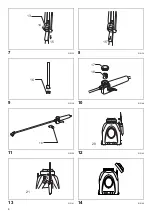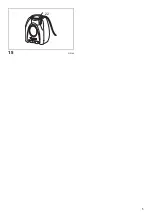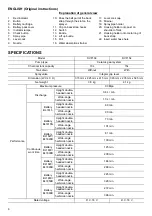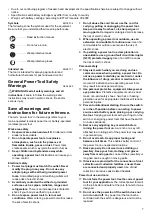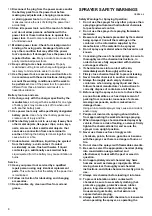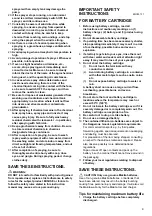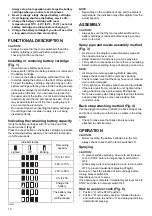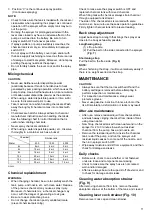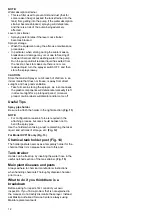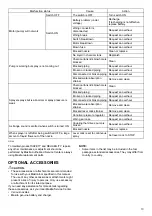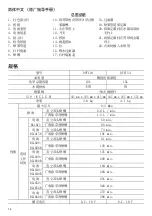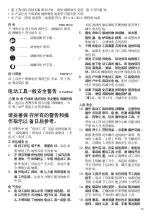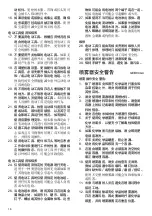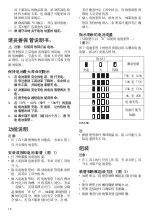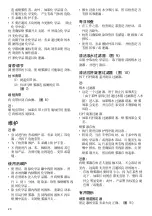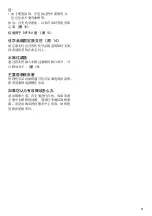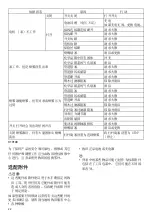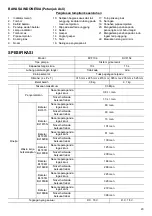
8
19.
Disconnect the plug from the power source and/or
the battery pack from the power tool before
making any adjustments, changing accessories,
or storing power tools.
Such preventive safety
measures reduce the risk of starting the power tool
accidentally.
20.
Store idle power tools out of the reach of children
and do not allow persons unfamiliar with the
power tool or these instructions to operate the
power tool.
Power tools are dangerous in the hands
of untrained users.
21.
Maintain power tools. Check for misalignment or
binding of moving parts, breakage of parts and
any other condition that may affect the power
tool’s operation. If damaged, have the power tool
repaired before use.
Many accidents are caused by
poorly maintained power tools.
22.
Keep cutting tools sharp and clean.
Properly
maintained cutting tools with sharp cutting edges are
less likely to bind and are easier to control.
23.
Use the power tool, accessories and tool bits etc.
in accordance with these instructions, taking into
account the working conditions and the work to
be performed.
Use of the power tool for operations
different from those intended could result in a
hazardous situation.
Battery tool use and care
24.
Recharge only with the charger specified by the
manufacturer.
A charger that is suitable for one type
of battery pack may create a risk of fire when used
with another battery pack.
25.
Use power tools only with specifically designated
battery packs.
Use of any other battery packs may
create a risk of injury and fire.
26.
When battery pack is not in use, keep it away from
other metal objects, like paper clips, coins, keys,
nails, screws or other small metal objects, that
can make a connection from one terminal to
another.
Shorting the battery terminals together may
cause burns or a fire.
27.
Under abusive conditions, liquid may be ejected
from the battery; avoid contact. If contact
accidentally occurs, flush with water. If liquid
contacts eyes, additionally seek medical help.
Liquid ejected from the battery may cause irritation or
burns.
Service
28.
Have your power tool serviced by a qualified
repair person using only identical replacement
parts.
This will ensure that the safety of the power tool
is maintained.
29.
Follow instruction for lubricating and changing
accessories.
30.
Keep handles dry, clean and free from oil and
grease.
SPRAYER SAFETY WARNINGS
GEB044-4
Safety Warnings for Spraying Operation:
1.
Do not use the sprayer for any other purpose than
spraying agricultural and horticultural chemicals
for pest and weed control.
2.
Do not use the sprayer for spraying flammable
materials.
3.
Be aware of any hazards presented by the material
being sprayed. Consult the markings on the
container or the information supplied by the
manufacturer of the material to be sprayed.
4.
Do not spray any material where the hazard is not
known.
5.
Concerning the use of chemical sprays, be sure to
thoroughly read the chemical instructions, in
order to become fully acquainted with toxicities
and usage methods.
6.
If chemical comes into contact with skin,
immediately wash thoroughly with soap.
7.
Firmly close chemical tank lid to prevent leaking.
8.
Never transfer chemical to another container.
9.
Always thoroughly wash empty chemical
containers when mixing spray liquid and then
follow chemical manufacturer’s instructions to
correctly dispose of containers at all times.
10.
Before using the sprayer, be sure to check there
are no abnormalities, such as displacement of
packing from connector, looseness of screws,
missing components, and/or cracked/worn/
damaged hose.
Using an incomplete sprayer may cause an accident
and/or injury.
11.
People not involved in spraying should refrain
from approaching the worksite during spraying.
12.
When transporting a chemical-loaded sprayer by
vehicle, there is a risk of leaking, so always firmly
tighten the chemical tank lid, and secure the
sprayer in an upright position.
13.
Never use items such as strongly acidic
chemicals, paints, thinners, gasoline or benzene
with the sprayer, as there is a danger of burns or
fire.
14.
Do not clean the sprayer with flammable solvents.
15.
Be sure to select the appropriate chemical (taking
into consideration usage method and
effectiveness) to deal with the pest or weed in
question.
16.
An inappropriately mixed chemical may harm
humans as well as damage crops/plants. When
mixing chemical, thoroughly read chemical
instructions, and dilute chemical correctly prior to
use.
17.
Always mix chemical before loading it into tank.
18.
To prevent inhalation and/or contact with
chemical, be sure to wear safety clothing (hat,
protective goggles, protective mask, rubber
gloves, long-sleeved pest-control jacket, long
trousers and gumboots), so that skin is not
exposed when spraying.
19.
Always load the tank with chemical or clean water
when operating the sprayer, as operating the
Summary of Contents for DVF104
Page 2: ...2 1 012664 2 015676 3 010133 1 2 3 4 5 6 7 8 9 ...
Page 3: ...3 4 014444 5 010143 6 010137 DVF104 DVF154 10 11 11 12 A B C ...
Page 5: ...5 15 010145 22 ...
Page 50: ...50 Q l T ...
Page 51: ...51 ...

